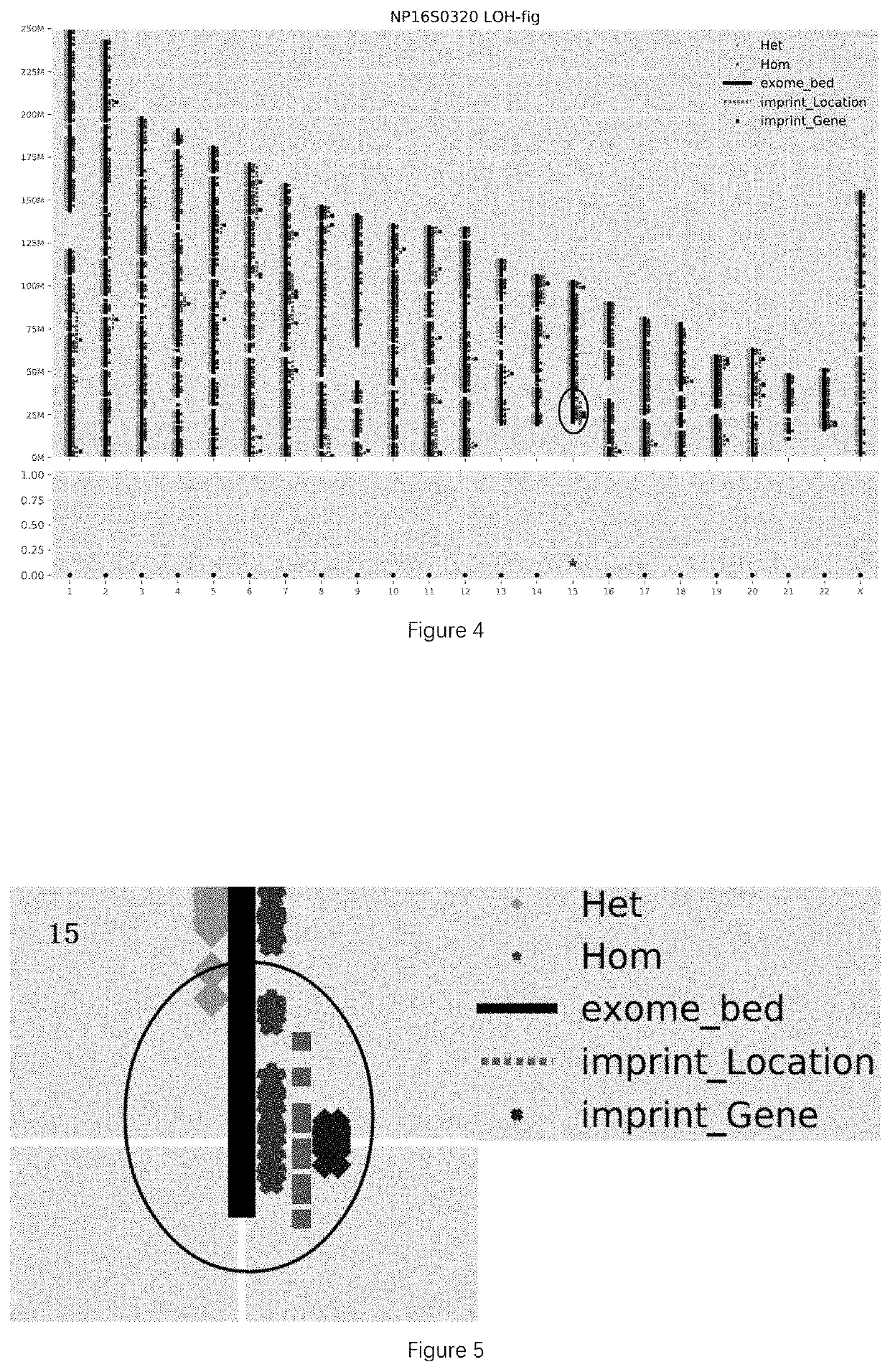Method for screening pathogenic uniparental disomy and use thereof
a pathogenic and uniparental technology, applied in the field of pathogenic uniparental disomy screening, can solve the problems of low efficiency and slow speed, unsuitable methylation method for genome-wide screening, and disordered expression of genes
- Summary
- Abstract
- Description
- Claims
- Application Information
AI Technical Summary
Benefits of technology
Problems solved by technology
Method used
Image
Examples
example 1
[0083]A method for screening a pathogenic uniparental disomy, comprise the steps as follows:
[0084]1. Obtaining Data
[0085]The whole exome sequencing data of one sample was obtained, wherein there were 59312 mutations.
[0086]2. Screening for Sites
[0087]2.1 Screening for High-quality Mutation Sites
[0088]The high-quality mutation sites were screened in the whole exome sequencing data, specifically, the high-quality mutation sites were those passed through a quality control of GATK-VQSR, and having a total coverage range of more than 40X and a mutation frequency of greater than 30%. In this sample, there were 45260 mutations.
[0089]2.2 Removing Y Chromosome Mutations
[0090]The mutations on Y chromosome were removed from the above mutation sites, to obtain 45256 mutations.
[0091]2.3 Screening for Point Mutations
[0092]The point mutations were screened out from the mutations obtained in the step of removing Y chromosome to obtain 41273 mutations.
[0093]2.4 Screening for Allele Frequency
[0094]Sit...
example 2
[0106]A screening of a pathogenic UPD was performed on a sample by using the method of Example 1, wherein:
[0107]1. Obtaining Data
[0108]It was performed with reference to Example 1.
[0109]2. Screening for Sites
[0110]It was performed with reference to Example 1, and 22210 mutations meeting the pre-determined conditions were obtained.
[0111]3. Judging LOH
[0112]For the above obtained sites, a region was judged to be LOH if a product of an amount of contiguous homozygous sites and the coverage range thereof was greater than 200 Mbp, wherein the amount of contiguous homozygous sites was greater than or equal to 20, and the coverage range was greater than or equal to 3 Mbp.
[0113]According to the above rule, there was 1 LOH region detected in the sample of this example, as shown in TABLE 2.
TABLE 2LOH RegionsCoverageRange ofAmount ofcontiguousStartEndhomozygoushomozygousImprinted ChromosomePositionPositionmutationssites(M)Imprinted genebandchr1522369343346492471912.28SNRPN, MAGEL2, 15q11-q12, ...
example 3
[0121]A screening of a pathogenic UPD was performed on a sample by using the method of Example 1, wherein:
[0122]1. Obtaining Data
[0123]It was performed with reference to Example 1.
[0124]2. Screening for Sites
[0125]It was performed with reference to Example 1, and 22947 mutations meeting the pre-determined conditions were obtained.
[0126]3. Judging LOH
[0127]For the above obtained sites, a region was judged to be LOH if a product of an amount of contiguous homozygous sites and the coverage range thereof was greater than 200 Mbp, wherein the amount of contiguous homozygous sites was greater than or equal to 20, and the coverage range was greater than or equal to 3 Mbp.
[0128]According to the above rule, there were 2 LOH regions detected in the sample of this example, as shown in TABLE 3.
TABLE 3LOH RegionsCoverageRange ofAmount ofcontiguousStart EndhomozygoushomozygousImprinted ImprintedChromosomePositionPositionmutationssites(M)genebandchr527484279635071026293.6ERAP2, 5q15RNU5D-1chr51676...
PUM
 Login to View More
Login to View More Abstract
Description
Claims
Application Information
 Login to View More
Login to View More - R&D
- Intellectual Property
- Life Sciences
- Materials
- Tech Scout
- Unparalleled Data Quality
- Higher Quality Content
- 60% Fewer Hallucinations
Browse by: Latest US Patents, China's latest patents, Technical Efficacy Thesaurus, Application Domain, Technology Topic, Popular Technical Reports.
© 2025 PatSnap. All rights reserved.Legal|Privacy policy|Modern Slavery Act Transparency Statement|Sitemap|About US| Contact US: help@patsnap.com



